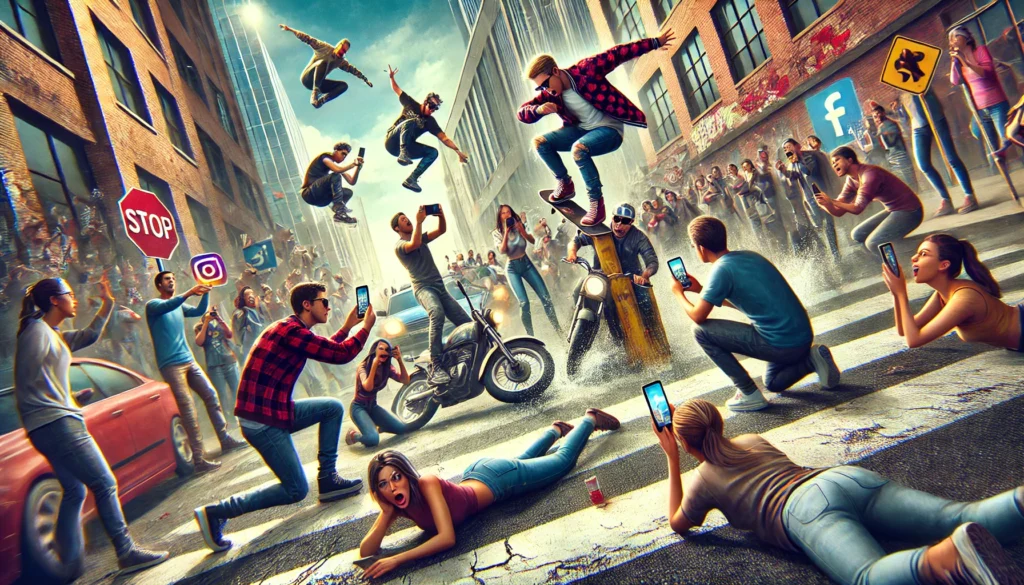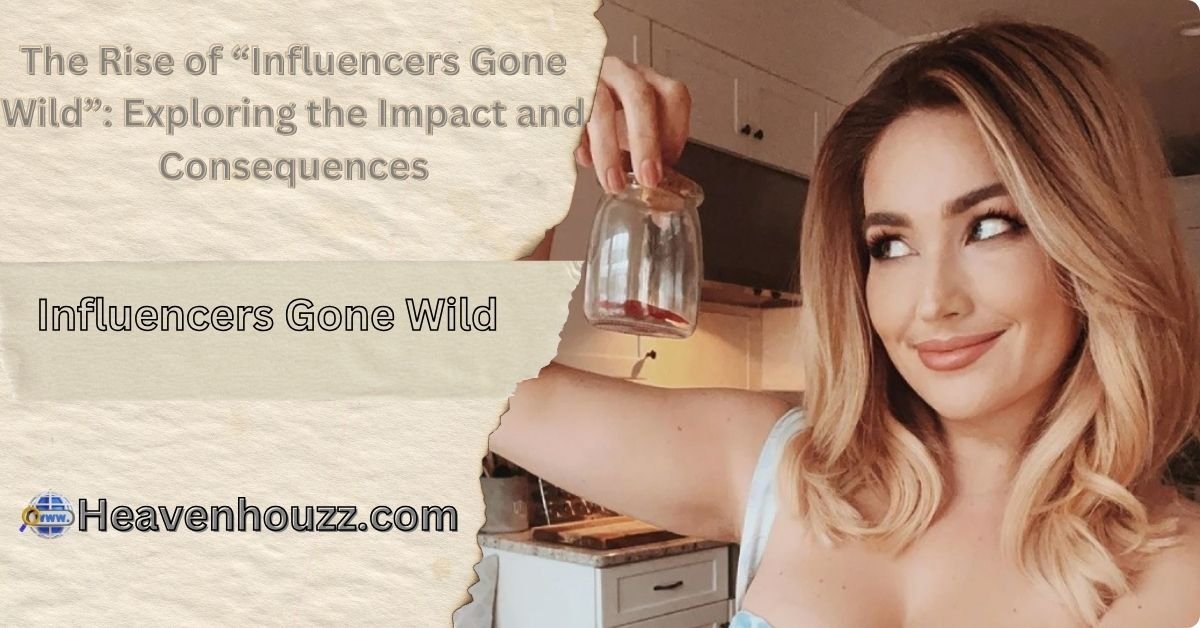Contents
Introduction to Influencers Gone Wild
In recent years, social media influencers have become some of the most influential voices on the internet. With massive followings on platforms like Instagram, TikTok, and YouTube, these personalities can shape trends, promote brands, and influence public opinion. However, significant influence comes great responsibility, and not all influencers handle this power responsibly. “Influencers Gone Wild” refers to the increasingly frequent instances of influencers behaving inappropriately or controversially in the public eye, causing widespread backlash and debate.
From wild public stunts to offensive comments, influencers gone wild have become a viral spectacle, blurring the lines between entertainment and ethical behavior. This article delves into the rise of this trend, its consequences for influencers and their followers, and its larger impact on social media culture.
What Does “Influencers Gone Wild” Mean?

Defining the Trend
The term “Influencers Gone Wild” refers to situations where influencers, typically known for their curated and polished online personas, engage in wild, reckless, or controversial behavior. These incidents can range from offensive social media posts and inappropriate comments to wild stunts designed to grab attention. In many cases, these actions lead to backlash from fans, sponsors, and the general public.
The rise of this trend is closely tied to the influencer’s desire for attention and virality. In an oversaturated digital world, where thousands of influencers are vying for the same spotlight, some individuals resort to outrageous behavior to stand out. While this strategy often garners immediate attention, it can come at the cost of their reputation and long-term success.
Examples of Influencers Gone Wild
Numerous examples of influencers whose wild behavior has landed them in hot water. Whether it’s inappropriate pranks, insensitive remarks, or reckless public behavior, these moments have become viral sensations. Some famous examples include:
- Influencers breaking COVID-19 restrictions by hosting large parties
- Offensive or tone-deaf remarks about sensitive social issues
- Public altercations with fans or other influencers
- Stunts that endanger the safety of themselves and others
While these incidents may bring short-term fame, they often have long-term consequences for the influencers and the broader social media culture.
The Impact of Influencers Gone Wild on Digital Culture
A Race for Attention and Virality
One of the key drivers behind the “Influencers Gone Wild” phenomenon is the competitive nature of the influencer economy. With so many personalities vying for attention, influencers feel the pressure to push boundaries and create content that will go viral. However, this race for attention often leads to reckless behavior, as influencers prioritize shock value over responsibility.
For example, some influencers have engaged in dangerous or illegal stunts just to get more views or likes. These actions put the influencers at risk and send harmful messages to their impressionable followers, who may be encouraged to replicate such behavior in pursuit of online fame.
The Impact on Young Audiences
Many social media influencers have a large following of young, impressionable viewers who look up to them as role models. When influencers engage in wild or inappropriate behavior, it can negatively influence these followers. Young audiences may interpret such actions as acceptable or desirable, leading to a normalization of reckless behavior.
Additionally, the viral nature of “Influencers Gone Wild” moments can lead to toxic online environments where controversial and harmful behavior is rewarded with attention and fame. This can further perpetuate the cycle of influencers engaging in wild stunts to stay relevant.
The Role of Social Media Platforms
Social media platforms like Instagram, TikTok, and YouTube also play a significant role in the “Influencers Gone Wild” phenomenon. These platforms thrive on engagement, and content that sparks strong reactions—whether positive or negative—tends to receive more visibility through algorithms that prioritize virality. As a result, influencers who engage in controversial behavior may find their content amplified, even if it damages their reputation or harms their audience.
While some platforms have introduced measures to curb inappropriate behavior—such as content moderation, reporting systems, and community guidelines—many argue that more needs to be done to hold influencers accountable for their actions. Ultimately, platforms are responsible for ensuring that the content promoted on their sites aligns with ethical standards and does not harm users.
Consequences for Influencers Who Go Wild

Damage to Reputation and Loss of Credibility
When influencers go wild, the most immediate consequence is often a significant hit to their reputation. Followers may lose trust in the influencer, especially if the behavior goes against their initially promoted values. For example, influencers who preach body positivity or kindness but engage in public shaming or offensive behavior can quickly lose credibility.
Additionally, rebuilding trust with an influencer’s audience can be incredibly challenging once their reputation is damaged. Many influencers involved in controversies have had to issue public apologies and take time away from social media to rebuild their image, but the damage often lingers.
Losing Brand Deals and Sponsorships
Another significant consequence of “Influencers Gone Wild” is the loss of brand deals and sponsorships. Many influencers rely on partnerships with companies to generate income, and brands are typically cautious about associating their products with individuals involved in controversy. A single scandal can result in a loss of lucrative sponsorships, which can significantly impact the influencer.
For brands, aligning with influencers who engage in controversial or inappropriate behavior can result in negative publicity and damage their image. As a result, companies are increasingly conducting thorough background checks and monitoring influencers’ online behavior to avoid being associated with scandals.
Social Backlash and Cancel Culture
The phenomenon of “cancel culture” has become particularly relevant in the world of influencers. Cancel culture refers to the collective act of withdrawing support for a public figure in response to offensive behavior. When influencers go wild, they often face intense backlash from their followers, who may call for them to be “canceled.”
Being canceled can result in a sharp decline in followers, engagement, and overall popularity. While some influencers can recover from being canceled by issuing public apologies and changing their behavior, others find their careers permanently damaged by the fallout.
FAQs
What is meant by “Influencers Gone Wild”?
- “Influencers Gone Wild” refers to instances where influencers behave inappropriately or controversially, often in a bid for attention or virality. This can include offensive comments, dangerous stunts, or inappropriate actions in public.
Why do influencers engage in wild behavior?
- Influencers may engage in wild behavior to stand out in a highly competitive space where attention and virality are crucial to success. However, this behavior often backfires and results in negative consequences such as backlash, loss of sponsorships, and damage to reputation.
How does “Influencers Gone Wild” affect young audiences?
- Young audiences, who often look up to influencers as role models, can be negatively impacted by wild or reckless behavior. They may view such actions as acceptable or desirable, normalizing inappropriate behavior on social media.
What are the consequences for influencers who go wild?
- Influencers who engage in wild behavior often face damage to their reputation, loss of credibility, brand deals, and social backlash. In extreme cases, they may be “canceled” by their audience and face long-term damage to their career.
Can influencers recover from a “gone wild” scandal?
- Some influencers recover from scandals by issuing public apologies, taking time away from social media, and making efforts to change their behavior. However, the recovery process can be challenging, and not all influencers can regain their former popularity.
What role do social media platforms play in the “Influencers Gone Wild” phenomenon?
- Social media platforms contribute to the “Influencers Gone Wild” trend by promoting viral content, even if it’s controversial or harmful. While platforms have guidelines, some argue they need to do more to hold influencers accountable and prevent the spread of harmful content.
Conclusion
The rise of “Influencers Gone Wild” has significantly impacted both influencers and their audiences. While wild behavior may grab attention in the short term, it often leads to long-term consequences, including damage to reputation, loss of income, and social backlash. As influencers continue to shape digital culture, they and their audiences need to consider the ethical implications of their online actions.
In a digital world where fame can be fleeting, influencers must balance the desire for virality with a sense of responsibility to their followers and the broader community. Social media platforms, brands, and users must hold influencers accountable to ensure that online content promotes positive, responsible behavior.


